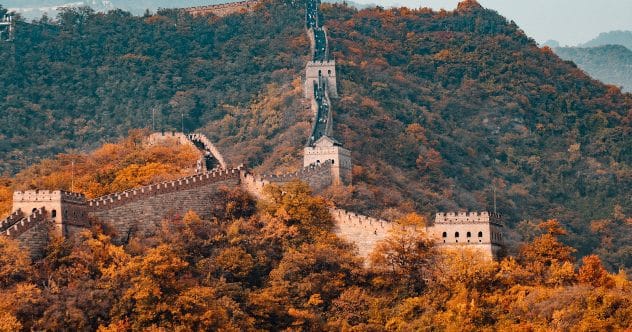The Great Wall of China stands as a powerful symbol of Chinese history and resilience. Stretching over thousands of miles, this ancient structure attracts millions of visitors each year. But beyond its impressive length and historical significance, there are many intriguing facts that remain relatively unknown. Let’s uncover some fascinating secrets behind this world wonder.
10. Workers Weren’t Buried in the Great Wall
A popular myth suggests that workers who died during the construction were buried within the wall itself. However, historical evidence doesn’t support this claim. The immense project demanded vast labor and resources, but there’s no indication that deceased workers were deliberately entombed in the wall. Instead, they were likely given proper burials, following the customs of the time. So, while working conditions were undoubtedly harsh, the legend of workers being buried alive remains just that—a legend.
9. The Great Wall Is Not a Continuous Wall
Contrary to common perception, the Great Wall isn’t a single, unbroken structure. It comprises a series of walls, fortifications, and natural barriers like mountains and rivers. These segments were constructed by different dynasties across centuries. The earliest sections date back to the 7th century BC. Over time, these various walls were connected to form a more cohesive defensive system. Today, visitors can explore different sections, each with its unique history and varying states of preservation.
8. The Great Wall Is Visible from Space
While the claim that the Great Wall is visible from the moon with the naked eye is a myth, it can be seen from space under specific conditions. NASA confirms that the structure can be observed with radar imaging, given the right weather. Its visibility stems from its construction on high ground and its contrast against the surrounding landscape. On clear days, the wall’s lighter color stands out against the darker terrain, making it discernible from space.
7. The Great Wall Was Built by Soldiers, Farmers, and Convicts
The construction of the Great Wall was a massive undertaking requiring a diverse workforce. General Meng Tian mobilized soldiers, local farmers, and even prisoners to complete the project. Farmers handled tasks like land clearing and foundation building, while convicts served as forced labor as a form of punishment. Skilled soldiers contributed their engineering and combat expertise. Despite the challenging conditions, their combined efforts resulted in one of the world’s most impressive architectural achievements.
8. The Great Wall Is Made of Rice
Various materials, including brick, tamped earth, and stone, were used to build the Great Wall. However, the binding agent is particularly interesting. The mortar used to hold the bricks and stones together included a unique ingredient: sticky rice! Originating during the Ming Dynasty, sticky rice mixed with slaked lime, sand, and water created a strong and durable mortar. The amylopectin in rice provided flexibility and resilience, helping structures withstand earthquakes and natural disasters. Some sections built with rice mortar remain standing strong centuries later.
5. The Great Wall Is a UNESCO World Heritage Site
Recognized as a UNESCO World Heritage Site, the Great Wall holds immense cultural significance worldwide. Its construction spanned thousands of years, from the 7th century BC through the Ming Dynasty (1368-1644). Stretching over 13,000 miles, it was built to protect the Chinese empire from northern invaders. Beyond its military purpose, the Great Wall symbolizes Chinese culture and identity, reflecting the ancient philosophy of “feng shui.” For centuries, it has inspired art, literature, and folklore, serving as a reminder of the importance of cultural heritage.
4. The Great Wall Has Strict Preservation Rules
With millions of visitors annually, preserving the Great Wall is a priority, leading to strict regulations. Taking bricks or stones as souvenirs is prohibited to maintain its original state. Alterations or modifications are forbidden, ensuring the wall’s integrity. Limits on visitor numbers prevent overcrowding and potential damage. Additionally, environmental measures, such as planting trees, protect the surrounding areas from erosion. These efforts aim to balance tourism with the preservation of this historical treasure.
3. The Great Wall Has Rich Cultural Significance
The Great Wall embodies China’s rich history, cultural identity, strength, unity, and perseverance. More than just a physical structure, it stands as a symbol of China’s enduring spirit. It has witnessed significant battles and cultural exchanges, inspiring generations to defend their homeland. Its design and construction highlight the ingenuity of ancient Chinese civilization, representing the country’s achievements in science and architecture. The Great Wall remains a powerful icon of Chinese heritage, captivating people worldwide.
2. The Great Wall Is Home to Rare Plants and Animals
The Great Wall’s surrounding areas are a biodiversity hotspot, housing around 1,000 plant and over 300 animal species. Many are rare or endangered, including the golden takin, Chinese goral, black-necked crane, and snow leopard. While giant pandas are no longer on the wall itself, they inhabit nearby forests. The Chinese giant salamander, the world’s largest amphibian, also resides here. Among the rare plants is the Chinese water fir, found only in China, and the Chinese trumpet creeper, known for its vibrant flowers, adding ecological value to this historic site.
1. The Great Wall Repurposes Caves
The Great Wall integrates natural caves and man-made tunnels for military purposes, providing shelter, storage, and secret passages. These caves also held cultural significance, with some serving as temples or shrines considered sacred. Believed to be spiritual gateways, they connected the earthly realm with the heavens. Today, many caves are accessible, offering insights into the wall’s past. Some have been transformed into museums, allowing visitors to explore the rich history and culture associated with this iconic landmark.
The Great Wall of China is more than just a wall; it’s a living testament to human ingenuity, cultural heritage, and natural wonder. These facts offer a glimpse into the depth and complexity of this iconic structure, enriching our understanding of its significance.
Did you enjoy learning these facts? Share your thoughts or any other interesting details you know about the Great Wall in the comments below!










